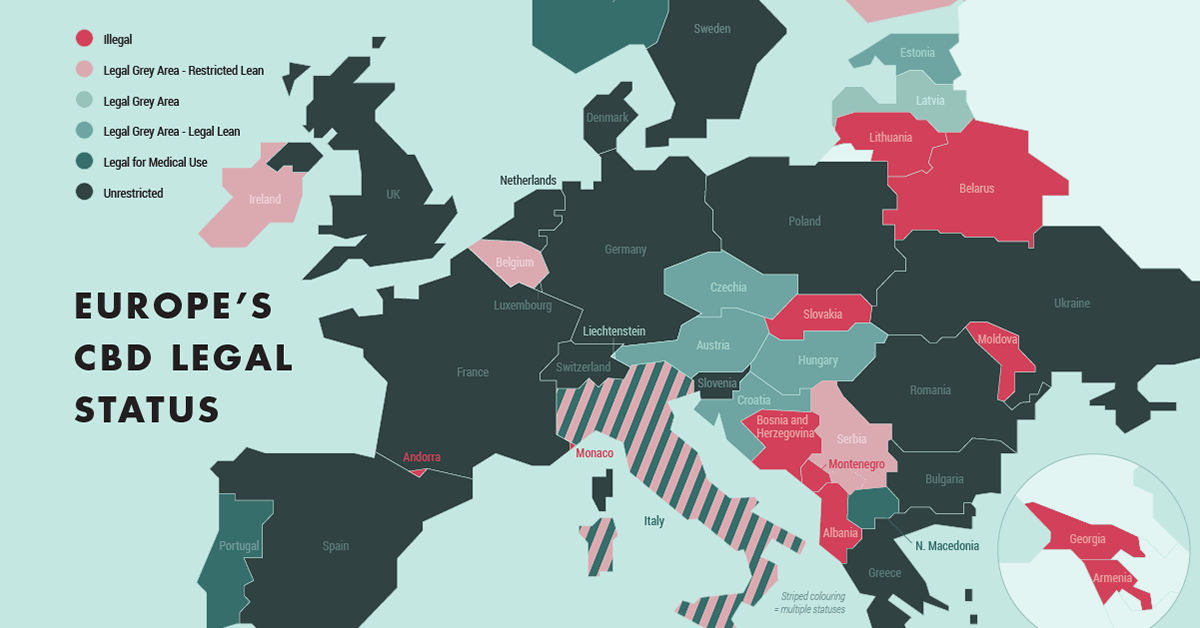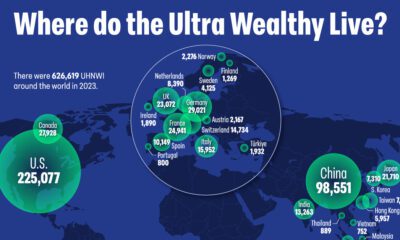Cannabis
Mapped: The European CBD Landscape in 2020
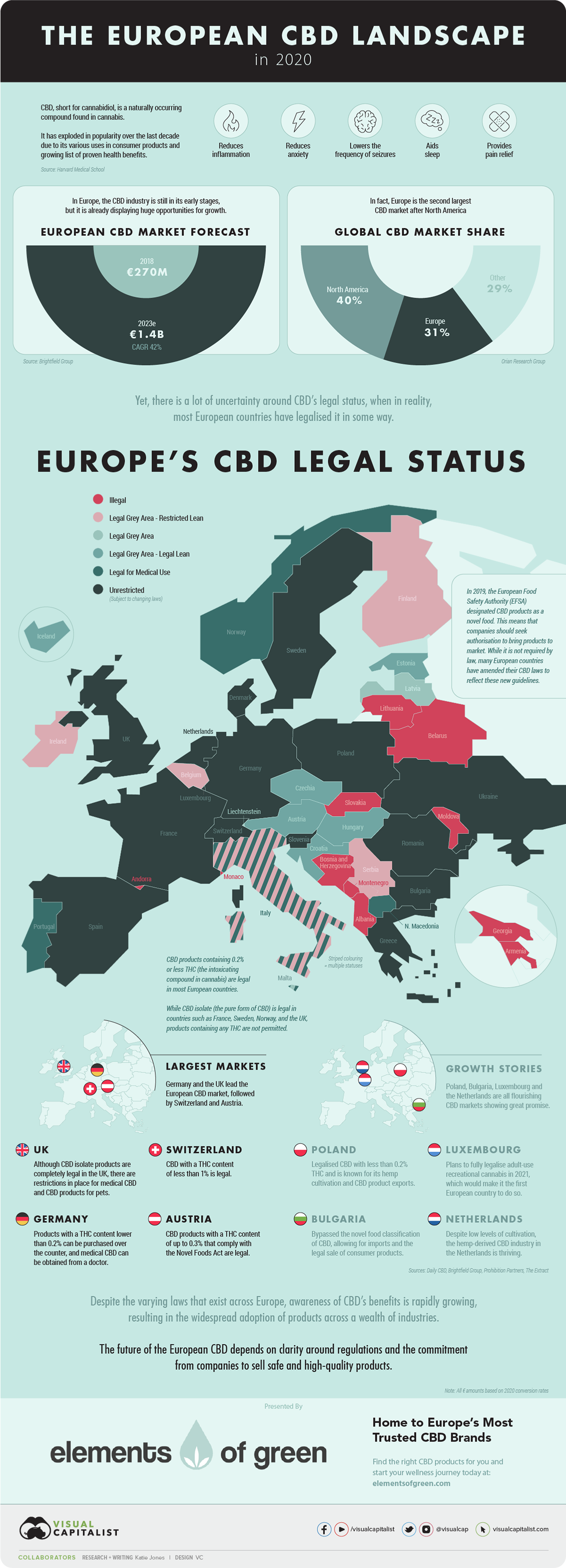
Mapped: The European CBD Landscape in 2020
To say CBD has risen in popularity over the last decade is an understatement.
Not only have CBD consumer products rapidly infiltrated a long list of industries, new research discoveries continue to prove their therapeutic benefits. By 2023, the European CBD market is estimated to reach €1.4 billion.
However, a big problem remains—there is an incredible amount of uncertainty surrounding what is legal, and what isn’t. The above infographic from Elements of Green sheds some light on the innately complex legal status of CBD products in Europe.
The Great CBD Debate
CBD—short for cannabidiol—is a non-psychotropic compound produced by cannabis plants.
While most European countries have legalised it in some way, the caveat for many is that it must be extracted from industrial hemp, thus containing less than 0.2% THC—the intoxicating compound also found in cannabis. On the other hand, countries such as France and Norway only permit CBD isolate (the pure form of CBD) with no THC.
In 2019, the European Food Safety Authority (EFSA) designated CBD products as a novel food. This means that companies should seek authorisation to bring products to market, although it is not required by law.
However, the industry has now hit a fork in the road, as the European Commission (EC) recently announced it will be suspending applications for novel foods status while it determines whether or not certain CBD products should be labelled as narcotics instead.
The Legal Landscape in 2020
As the industry flip flops between regulations, consumers and investors need to understand that each country has its own laws surrounding the use of CBD.
| Country | CBD Legal Staus |
|---|---|
| 🇦🇱 Albania | Illegal |
| 🇦🇩 Andorra | Illegal |
| 🇦🇲 Armenia | Illegal |
| 🇦🇹 Austria | Legal grey area (legal lean) |
| 🇧🇾 Belarus | Illegal |
| 🇧🇦 Bosnia and Herzegovina | Illegal |
| 🇧🇪 Belgium | Legal grey area (restricted lean) |
| 🇧🇬 Bulgaria | Unrestricted |
| 🇨🇿 Czech Republic | Legal grey area (legal lean) |
| 🇭🇷 Croatia | Legal grey area (legal lean) |
| 🇩🇰 Denmark | Unrestricted |
| 🇪🇪 Estonia | Legal grey area (legal lean) |
| 🇫🇮 Finland | Legal grey area (restricted lean) |
| 🇫🇷 France | Unrestricted |
| 🇬🇪 Georgia | Illegal |
| 🇩🇪 Germany | Unrestricted |
| 🇬🇷 Greece | Unrestricted |
| 🇭🇺 Hungary | Legal grey area (legal lean) |
| 🇮🇸 Iceland | Legal grey area (legal lean) |
| 🇮🇪 Ireland | Legal grey area (restricted lean) |
| 🇮🇹 Italy | Legal grey area (restricted lean/legal for medical use) |
| 🇱🇻 Latvia | Legal grey area |
| 🇱🇮Liechtenstein | Legal grey area |
| 🇱🇹 Lithuania | Illegal |
| 🇱🇺 Luxembourg | Unrestricted |
| 🇲🇹 Malta | Legal grey area/legal for medical use |
| 🇲🇩 Moldova | Illegal |
| 🇲🇨 Monaco | Illegal |
| 🇲🇪 Montenegro | Illegal |
| 🇳🇱 Netherlands | Unrestricted |
| 🇲🇰 North Macedonia | Legal for medical use |
| 🇳🇴 Norway | Legal for medical use |
| 🇵🇱 Poland | Unrestricted |
| 🇵🇹 Portugal | Legal for medical use |
| 🇷🇴 Romania | Unrestricted |
| 🇷🇸 Serbia | Legal grey area (restricted lean) |
| 🇸🇰 Slovakia | Illegal |
| 🇸🇮 Slovenia | Unrestricted |
| 🇪🇸 Spain | Unrestricted |
| 🇸🇪 Sweden | Unrestricted |
| 🇨🇭 Switzerland | Unrestricted |
| 🇺🇦 Ukraine | Unrestricted |
| 🇬🇧 United Kingdom | Unrestricted |
While a handful of European countries have made it illegal to import, buy, or possess CBD, the vast majority have legalised CBD products that either comply with the Novel Foods Act, or can be obtained from a licensed medical practitioner.
Of these countries, Germany and the UK lead the European CBD market, followed by Switzerland, Austria, Spain, and Greece.
A Call For Change
A progessive stance on cannabis legalisation combined with increasing consumer demand has led to several countries showing remarkable growth, such as Poland, Bulgaria, Netherlands, and Luxembourg.
Luxembourg in particular presents a compelling growth story, as it plans to fully legalise adult-use recreational cannabis in 2021, which would make it the first European country to do so.
Despite its small size, Luxembourg could in fact be instrumental in encouraging neighbouring countries to implement similar reforms, also known as the neighbour effect.
Growing Pains of a Nascent Industry
Considering each country has its own unique restrictions in place, CBD consumers should educate themselves on the regulations and laws relevant to them.
Despite these often confusing laws and restrictions, it is clear that demand for CBD products is growing exponentially. As a result, the continent may have the potential to overtake North America as the largest CBD market in the world.
Politics
Timeline: Cannabis Legislation in the U.S.
At the federal level, cannabis is illegal, but state laws differ. This graphic looks at the timelines of cannabis legislation in the U.S.
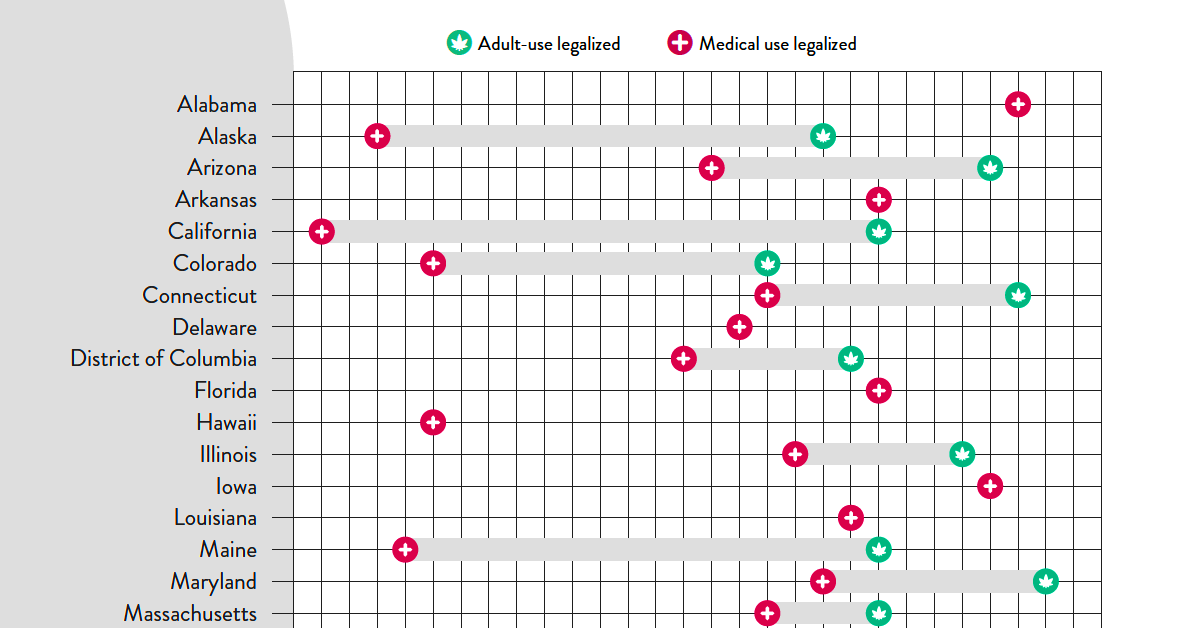
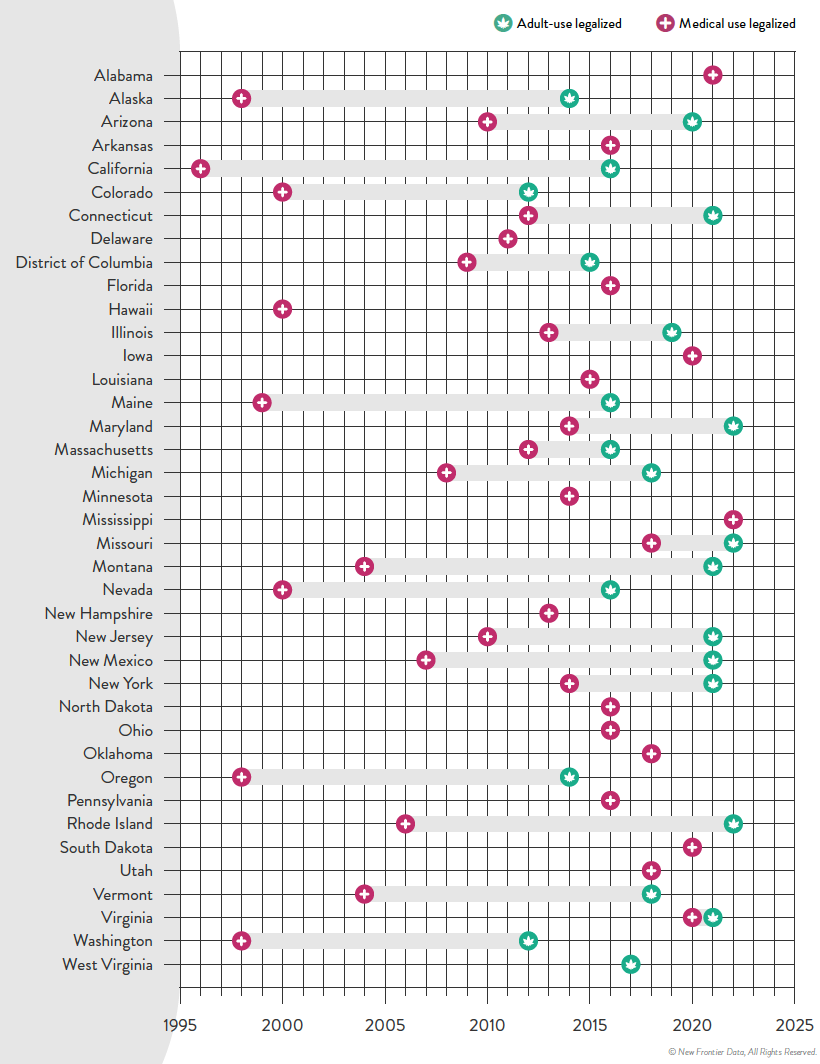
Timeline: Cannabis Legislation in the U.S.
At the federal level, cannabis is still considered an illegal substance. That said, individual states do have the right to determine their own laws around cannabis sales and usage.
This visual from New Frontier Data looks at the status of cannabis in every state and the timeline of when medical and/or recreational use became legal.
Cannabis Through the Years
In the U.S., the oldest legalese concerning cannabis dates back to the 1600s—the colony of Virginia required every farm to grow and produce hemp. Since then, cannabis use was fairly wide open until the 1930s when the Marihuana Tax Act was enforced, prohibiting marijuana federally but still technically allowing medical use.
Jumping ahead, the Controlled Substances Act was passed in 1970, classifying cannabis as Schedule I drug—the same category as heroin. This prohibited any use of the substance.
However, the 1970s also saw a counter movement, wherein many states made the move towards decriminalization. Decriminalization means that although possessing cannabis remained illegal, a person would not be subject to jail time or prosecution for possessing certain amounts.
By the 1990s, some of the first states passed laws to allow the medical usage of cannabis, and by 2012 two states in the U.S.—Washington and Colorado—legalized the recreational use of cannabis.
Cannabis Legislation Today and Beyond
The MORE Act (the Marijuana Opportunity Reinvestment and Expungement Act) was passed in the House early 2022, and if made law, it would decriminalize marijuana federally.
“This bill decriminalizes marijuana. Specifically, it removes marijuana from the list of scheduled substances under the Controlled Substances Act and eliminates criminal penalties for an individual who manufactures, distributes, or possesses marijuana.”– U.S. Congress
Cannabis still remains illegal at the federal level, but at the state levels, cannabis is now fully legal (both for medicinal and recreational purposes) in a total of 22 states.
Over 246 million Americans have legal access to some form of marijuana products with high THC levels. Looking to the future, many new cannabis markets are expected to open up in the next few years:
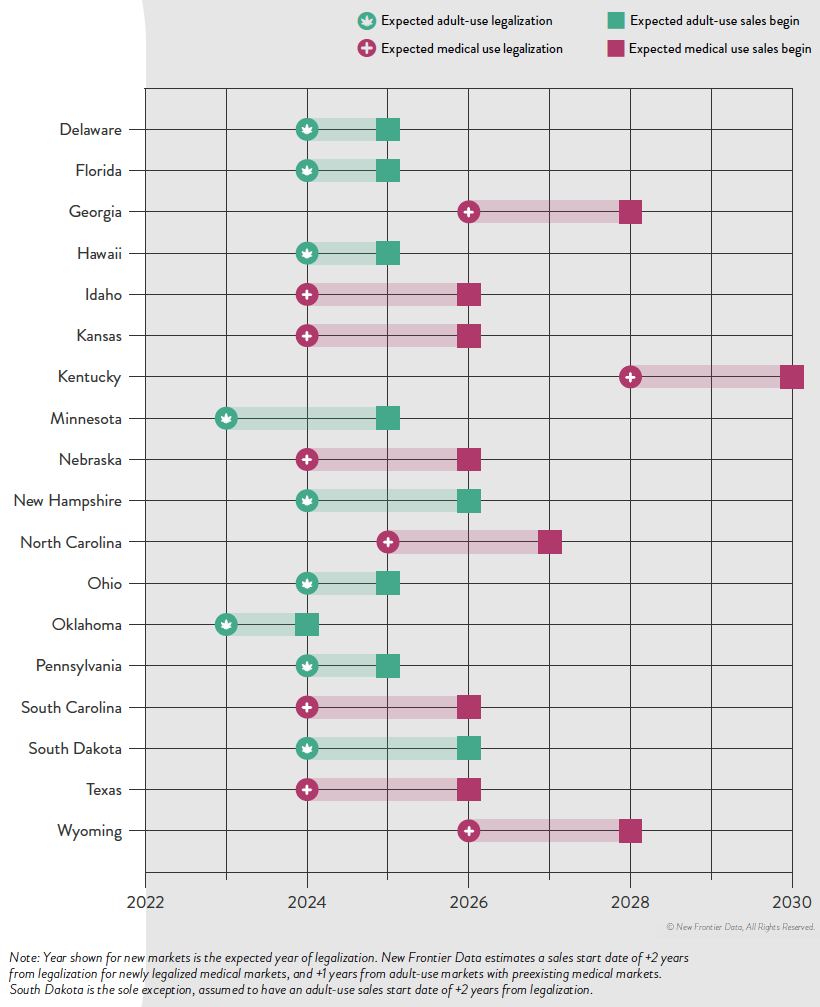
The earliest states expected to open up next for recreational cannabis sales are Minnesota and Oklahoma. There is always a lag between legalization and actual sales, wherein local regulatory bodies and governments set standards. States like Kentucky, on the other hand, aren’t likely to even legalize medicinal cannabis until 2028.
It’s estimated that by 2030, there will be 69 million cannabis consumers in the country, up 33% from 2022.
Overall, the U.S. cannabis market is likely an important one to watch as legal sales hit $30 billion in 2022. By the end of the decade, that number is expected to be anywhere from $58 billion to as much as $72 billion.
-

 Debt1 week ago
Debt1 week agoHow Debt-to-GDP Ratios Have Changed Since 2000
-

 Markets2 weeks ago
Markets2 weeks agoRanked: The World’s Top Flight Routes, by Revenue
-

 Countries2 weeks ago
Countries2 weeks agoPopulation Projections: The World’s 6 Largest Countries in 2075
-

 Markets2 weeks ago
Markets2 weeks agoThe Top 10 States by Real GDP Growth in 2023
-

 Demographics2 weeks ago
Demographics2 weeks agoThe Smallest Gender Wage Gaps in OECD Countries
-

 United States2 weeks ago
United States2 weeks agoWhere U.S. Inflation Hit the Hardest in March 2024
-

 Green2 weeks ago
Green2 weeks agoTop Countries By Forest Growth Since 2001
-

 United States2 weeks ago
United States2 weeks agoRanked: The Largest U.S. Corporations by Number of Employees

